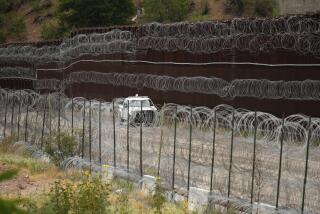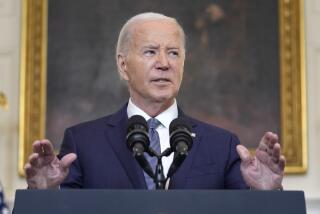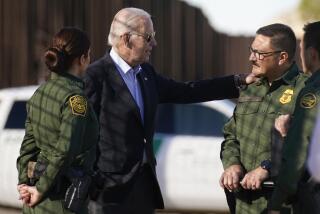Trump orders new and narrower travel ban that goes into effect in 10 days
Reporting from Washington — President Trump ordered that entry to the U.S. be suspended for residents from six Muslim-majority countries and blocked refugees from around the world Monday, retooling the executive order that stoked chaos at airports and drew international condemnation and a rebuke in the courts.
Trump removed Iraqis from the list of travelers who were temporarily banned, clarified that holders of visas and green cards can come to the U.S. and took other steps aimed at ensuring the order holds up in court.
Though far narrower than what Trump promised on the campaign trail, the order had its roots in his December 2015 pledge to ban all Muslims from entering the country. And while temporary, the order lays the foundation for further restrictions on travel and asylum as Trump opens another front in his effort to tighten the nation’s borders.
Trump has long argued that the immigration system is failing to protect the nation from the threat of terrorism and that previous leaders were too timid to put American interests ahead of global opinion.
“Like every nation, the United States has a right to control who enters our country and to keep out those who would do us harm,” Atty. Gen. Jeff Sessions said during an announcement alongside Secretary of State Rex Tillerson and Homeland Security Secretary John F. Kelly.
Opponents argued that even if Trump is not banning all Muslims, his narrower measure still amounts to religious profiling, and sends a message that undermines American values and helps terrorist organizations recruit. They say Trump’s travel suspension and refugee ban are too broad and arbitrary to enhance safety, leaving out, for example, the countries that spawned the Sept. 11 attackers.
“A watered-down ban is still a ban,” said Senate Minority Leader Charles E. Schumer (D-N.Y.). “Despite the administration’s changes, this dangerous executive order makes us less safe, not more. It is mean-spirited and un-American. It must be repealed.”
Read President Trump’s new executive order on travel and refugees »
The ban, which takes effect March 16, halts travel for 90 days for residents of Iran, Libya, Somalia, Sudan, Syria and Yemen. The refugee suspension will last 120 days.
Iraq, whose citizens and nationals had been on the earlier list of banned travelers, was removed after officials there agreed to accept all Iraqis being deported from the U.S.
Though Trump has repeatedly called the war in Iraq a disaster, language in the revised order praises the country’s “democratically elected government” for close cooperation in fighting Islamic State terrorists and vetting travelers.
Trump had faced criticism from military leaders for initially banning Iraqis who put their lives at risk to help U.S. troops. The Iraqi government had also threatened retaliation that could have blocked U.S. aid workers, journalists and contractors from working in the country.
The new ban also puts a 120-day limit on what had been an indefinite suspension on accepting refugees from Syria and removes language intended to help Christian refugees and other religious minorities facing persecution in winning asylum.
Those were among several changes to the order designed to insulate it from court challenges; the first one was blocked only days after it was issued. The new order also leaves time for agencies to implement it in hopes of alleviating the confusion that accompanied the original order, which was issued only a week after Trump took office and with little consultation from top agency officials.
“There should be no surprises — whether it’s in the media or on Capitol Hill,” Kelly said.
The new ban clarifies that permanent residents, dual citizens and those holding valid visas of all kinds — including for study, travel and work — will be allowed to enter the country or remain here, and it restores visas for those who had them revoked after the first travel ban was imposed. The order will give the State Department room for case-by-case exceptions.
Trump had defended the hasty manner in which the original order was crafted as necessary for security, claiming bad actors would try to enter the country if there was any delay in stopping them. Yet the new order not only took weeks to release, but it also provides time between Monday’s signing and next week’s effective date.
Many in Trump’s circle are eager to renew debate over the ban, which has been popular among Trump’s supporters, after several days of questions about the White House’s ties to Russia and a weekend in which Trump made unsubstantiated charges that President Obama was tapping his phones during the presidential campaign.
“This is a very important week in this White House, where the president is going to continue to act on, along with the Congress, major pieces of his legislative and executive agenda,” Kellyanne Conway, senior White House counselor, said on Fox News’ “Fox & Friends.”
Trump signed the order privately Monday morning.
Several Republican leaders in Congress praised the measure, though some emphasized its limited scope. Sen. Tom Cotton (R-Ark.) called the travel ban “just a short pause in accepting immigrants from these countries” while officials take “a harder look at people coming into our country from war-torn nations with known terrorist networks.”
Trump had vowed to keep fighting for the original order, tweeting “see you in court” after a pair of legal defeats that suspended enforcement of the ban, in part because it was seen as discriminatory toward Muslims.
Language in the new ban asserts that the original order was “not motivated by animus toward any religion,” pointing out that Muslims would have also qualified as persecuted religious minorities in some countries.
Despite the tough talk, the new travel ban ends the court fight on the old one, formally rescinding the original order next week, a step the administration’s lawyers had promised in court documents.
Trump’s press secretary, Sean Spicer, said the court fight was dropped to avoid prolonged litigation “that would have left the country exposed.”
Still, the new order will leave many of the former goals intact, while planting the seeds for further limits.
The order retains language that slows the entry of asylum seekers dramatically, capping the program at 50,000 refugees for the year, compared with 110,000 allowed under policies of the Obama administration. The U.S. has already accepted 35,000 refugees this fiscal year, which started Oct. 1, meaning only 15,000 more would be allowed in over the next seven months.
In addition to blocking visas from the six listed countries, the new orders require agencies to “take immediate steps” to create “enhanced vetting and screening procedures” for all foreigners wanting to visit the U.S., a senior Homeland Security official said.
After the new order is implemented next week, Homeland Security and State Department officials will examine every country in the world to ensure they are providing the U.S. enough information to vet their citizens appropriately, the Homeland Security official said. This review period could also be used as leverage to force countries to take back people that the U.S. would like to deport, the official said.
The order and a separate memo signed by Trump also require federal agencies to track and publish data on foreign nationals who have been “radicalized” or accused of terrorist activity and to create reports comparing the long-term costs of keeping refugees in America with the expense of supporting refugees in safe havens near their home countries.
In addition to concerns about a religious test, the courts faulted the implementation of the original order, which was signed Jan. 27.
An estimated 60,000 visa holders were blocked from entering the country, including some on airplanes bound for the U.S. The administration later allowed citizens from the seven affected countries who hold legal permanent residence in the U.S. to enter the country without a waiver.
Even though the second order is more narrowly tailored, opponents vowed to protest and are all but certain to file new legal challenges. Groups advocating for refugees, Muslims and others included in the ban issued strong condemnations.
“The Trump administration has conceded that its original Muslim ban was indefensible,” Omar Jadwat, director of the ACLU’s Immigrants’ Rights Project, said in a statement. “Unfortunately, it has replaced it with a scaled-back version that shares the same fatal flaws. The only way to actually fix the Muslim ban is not to have a Muslim ban.”
Times staff writers Lisa Mascaro in Washington and Jaweed Kaleem in Los Angeles contributed to this report.
Twitter: @noahbierman
Twitter: @mikememoli
Twitter: @ByBrianBennett
ALSO
Sessions’ testimony on Russia talks was false. Was it perjury?
The White House has found ways to end protection for ‘Dreamers’ while shielding Trump from blowback
UPDATES:
3:50 p.m.: The story was updated throughout with more details on the executive order and reaction from lawmakers.
10:50 a.m.: The story was updated with details on the refugee program caps applying for the fiscal year that started Oct. 1.
10:05 a.m.: The story was updated with comments from members of Trump’s Cabinet.
8:30 a.m.: The story was updated with President Trump signing the new executive order.
The story was originally published at 7:10 a.m.
More to Read
Get the L.A. Times Politics newsletter
Deeply reported insights into legislation, politics and policy from Sacramento, Washington and beyond. In your inbox three times per week.
You may occasionally receive promotional content from the Los Angeles Times.













